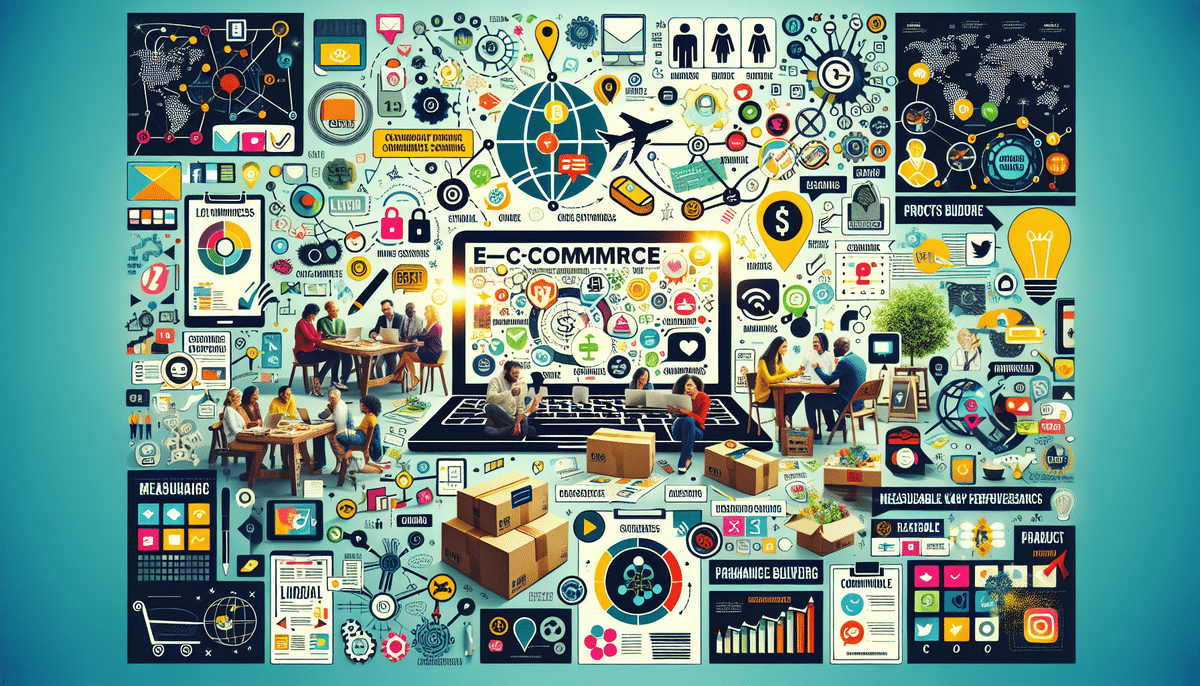How to Use Content Marketing to Grow Your Business
Content marketing has become a key strategy for businesses of all industries and sizes, helping them reach and engage their target audience, build brand awareness, and ultimately drive sales. In this article, we'll walk you through the basics of content marketing and show you how to use this powerful tool to grow your business in 12 actionable steps.
Understanding the Basics of Content Marketing
Content marketing is the creation and distribution of valuable, relevant content to a specific target audience with the goal of driving profitable customer action. The content can take many different forms, from blog posts, videos, and social media posts to infographics, podcasts, and whitepapers. The key is to provide your target audience with informative, entertaining, or educational content that they find valuable and engaging.
One of the benefits of content marketing is that it can help establish your brand as a thought leader in your industry. By consistently producing high-quality content that addresses the needs and interests of your target audience, you can position your brand as an authority in your field. This can help build trust with potential customers and make them more likely to choose your products or services over those of your competitors.
Another important aspect of content marketing is measuring its effectiveness. By tracking metrics such as website traffic, social media engagement, and lead generation, you can determine which types of content are resonating with your audience and adjust your strategy accordingly. According to a 2023 Content Marketing Report, businesses that utilize data-driven content strategies see a 30% increase in ROI.
The Benefits of Content Marketing for Your Business
The benefits of content marketing are numerous and varied:
- Builds Trust and Credibility: Establishes your business as an authority in your industry.
- Attracts and Retains Customers: Provides valuable content that keeps customers engaged.
- Improves SEO: Enhances your search engine rankings, increasing organic traffic.
- Increases Conversion Rates: Higher engagement leads to more conversions over time.
- Strengthens Brand Identity: Consistent content aligns with your brand values and messaging.
Additionally, content marketing offers opportunities for engagement, allowing your audience to comment, share, and interact with your content, thereby increasing brand awareness and customer loyalty.
Setting Goals for Your Content Marketing Strategy
Before you start creating content, it's crucial to set clear goals for your content marketing strategy. These goals should align with your overall business objectives and follow the SMART criteria:
- Specific: Clearly define what you want to achieve.
- Measurable: Ensure that you can track your progress.
- Achievable: Set realistic goals that are attainable.
- Relevant: Align goals with your business objectives.
- Time-bound: Set a deadline for achieving your goals.
For instance, your goal might be to increase website traffic by 25% within the next six months. Leveraging tools like Google Analytics can help you track key metrics such as website traffic, engagement rates, and conversion rates.
Regularly tracking and measuring your progress allows you to identify what's working and what needs adjustment, ensuring that your content marketing efforts are delivering a strong return on investment.
Identifying Your Target Audience and Their Needs
Understanding your target audience is foundational to successful content marketing. Key questions to consider include:
- Who are they?
- What do they care about?
- What challenges do they face?
Creating detailed buyer personas can help you tailor your content to address the specific needs and pain points of your audience. According to a study by ShipScience Industry Reports, businesses that develop comprehensive buyer personas are 2.5 times more likely to see positive results from their content marketing efforts.
Keep in mind that identifying your target audience is an ongoing process. As your business evolves, so may your audience. Regularly reassess and adjust your content strategy to ensure continued effectiveness.
Choosing the Right Type of Content for Your Business
Not all content is created equal. Choosing the right type of content depends on your goals, target audience, and available resources. Here are some common content types and their purposes:
- Blog Posts: Great for SEO and driving website traffic.
- Videos: Highly engaging and shareable, ideal for storytelling.
- Infographics: Perfect for simplifying complex information.
- Podcasts: Ideal for reaching audiences on the go.
- Whitepapers and E-books: Excellent for in-depth analysis and lead generation.
Consider the stage of the buyer's journey your audience is in:
- Aware Stage: Educational content like e-books or whitepapers.
- Consideration Stage: Case studies or product comparisons.
- Decision Stage: Product demos or testimonials.
Align your content types with your overall marketing strategy to ensure consistency and effectiveness.
Creating Engaging and High-Quality Content
The quality of your content is paramount to the success of your content marketing strategy. Here are some tips to create high-quality content:
- Conduct Original Research: Provide unique insights and data.
- Use Visual Aids: Incorporate images, videos, and infographics to enhance engagement.
- Incorporate Storytelling: Use narratives to make your content more relatable and memorable.
- Provide Actionable Takeaways: Ensure your audience can apply what they've learned.
Moreover, optimize your content for search engines by using relevant keywords and phrases throughout your content, including in headlines, subheadings, and meta descriptions. This increases the visibility of your content and attracts more traffic to your website.
Stay current by regularly updating your content and incorporating the latest industry trends and developments. This ensures that your content remains accurate, relevant, and valuable to your audience.
Promoting Your Content on Social Media Platforms
Social media is a powerful tool for promoting your content and reaching new audiences. Here’s how to effectively utilize different platforms:
- Twitter: Ideal for short, snappy updates and using hashtags to expand reach.
- Facebook: Great for sharing a variety of content types and engaging with communities.
- LinkedIn: Best for professional and longer-form content.
- Instagram: Perfect for visual content like images and short videos.
Consider using paid advertising on these platforms to extend your reach further. Monitor your social media channels for comments and feedback, and engage with your audience regularly to build relationships and foster loyalty.
According to recent data from ShipScience Social Media Trends 2023, businesses that actively engage on social media see a 20% increase in content sharing and a 15% boost in customer retention.
Building an Email List for Your Business through Content Marketing
Email marketing remains one of the most effective ways to reach your audience and promote your content. Here’s how to build and leverage an email list:
- Create Valuable Content: Offer incentives like exclusive content, discounts, or free resources in exchange for email subscriptions.
- Use Lead Magnets: E-books, whitepapers, and webinars can attract potential subscribers.
- Segment Your List: Tailor your emails to different segments of your audience for more personalized communication.
- Engage with Newsletters: Regular newsletters keep your audience informed and engaged with your latest content and offers.
Personalize your emails and ensure they provide value to encourage higher open and click-through rates. According to ShipScience's 2023 Email Marketing Statistics, businesses with personalized email campaigns see a 29% higher open rate and a 41% higher click-through rate.
Measuring the Success of Your Content Marketing Strategy
Measuring the success of your content marketing strategy is essential for continuous improvement. Here’s how to effectively measure your efforts:
- Website Analytics: Use tools like Google Analytics to track website traffic, bounce rates, and time on site.
- Engagement Metrics: Monitor metrics such as social shares, comments, and likes to gauge audience engagement.
- Conversion Rates: Track how many visitors are taking desired actions, such as signing up for a newsletter or making a purchase.
- Audience Feedback: Conduct surveys or gather feedback to understand your audience’s preferences and needs.
Additionally, analyze your social media metrics to understand how your content resonates with your audience. According to ShipScience Content Marketing Effectiveness, businesses that regularly measure their content marketing efforts are 1.5 times more likely to achieve their goals.
Keeping Up with the Latest Trends in Content Marketing
Content marketing is a constantly evolving field, with new trends, tools, and technologies emerging regularly. Staying up-to-date ensures your content remains fresh, relevant, and effective. Here are some ways to keep abreast of the latest trends:
- Attend Industry Events: Participate in webinars, conferences, and workshops.
- Read Blogs and Books: Follow reputable industry blogs and publications.
- Engage with Thought Leaders: Connect with industry experts on social media and professional networks.
- Experiment with New Formats: Try emerging content formats like interactive content, augmented reality, or live streaming.
According to ShipScience's Future of Content Marketing Report 2023, businesses that adapt to new content trends see a 25% increase in audience engagement.
Building Relationships with Influencers through Content Marketing
Influencer marketing is a powerful strategy to extend your reach and build authority in your industry. Here’s how to effectively collaborate with influencers:
- Identify Relevant Influencers: Look for influencers who align with your brand values and have an engaged audience.
- Build Genuine Relationships: Engage with influencers by sharing their content, commenting on their posts, and building rapport.
- Provide Value: Offer valuable content or incentives that influencers can share with their audiences.
- Collaborate on Content: Partner with influencers to create co-branded content, such as guest blog posts, joint webinars, or social media takeovers.
By leveraging the influence and networks of industry leaders, you can amplify your content's reach and credibility. According to ShipScience’s Influencer Marketing Statistics 2023, businesses that collaborate with influencers see a 20% increase in brand awareness and a 15% boost in sales.
How to Optimize Your Website for Better Search Engine Rankings with Content Marketing
Search engine optimization (SEO) is a critical component of any content marketing strategy, as it enhances your visibility and drives traffic from search engines like Google. Here are some tips to optimize your website:
- Create Keyword-Rich Content: Research and incorporate relevant keywords naturally within your content, including in titles, headings, and meta descriptions.
- Build Quality Inbound Links: Acquire backlinks from reputable websites to improve your site's authority.
- Enhance Site Speed and Mobile-Friendliness: Ensure your website loads quickly and is optimized for mobile devices.
- Use Schema Markup: Implement structured data to help search engines understand your content better.
- Regularly Update Content: Keep your content fresh and relevant by regularly updating it with new information and insights.
Additionally, leverage social media and other platforms to boost your search rankings. According to ShipScience’s SEO Content Marketing Guide, businesses that integrate SEO best practices into their content marketing see a 35% increase in organic search traffic.
Creating a Strong Brand Identity through Consistent Content Marketing
Content marketing plays a pivotal role in building a strong and consistent brand identity. Here’s how to achieve this:
- Define Your Brand Voice and Tone: Establish a consistent style that reflects your brand’s personality.
- Align Content with Brand Values: Ensure your content consistently communicates your brand’s mission, values, and unique selling propositions.
- Maintain Consistency Across Channels: Use the same branding elements, such as logos, colors, and fonts, across all content platforms.
- Tell Your Brand Story: Use storytelling to create an emotional connection with your audience.
A consistent brand identity fosters trust and recognition, leading to improved customer loyalty and increased word-of-mouth referrals. According to ShipScience’s Brand Identity Report 2023, businesses with a strong brand identity see a 50% increase in customer retention and a 40% boost in brand advocacy.
In conclusion, content marketing is a powerful tool for growing your business and engaging your target audience. By following these 12 steps, you can create an effective content marketing strategy that drives results and helps you achieve your business goals. Good luck!









